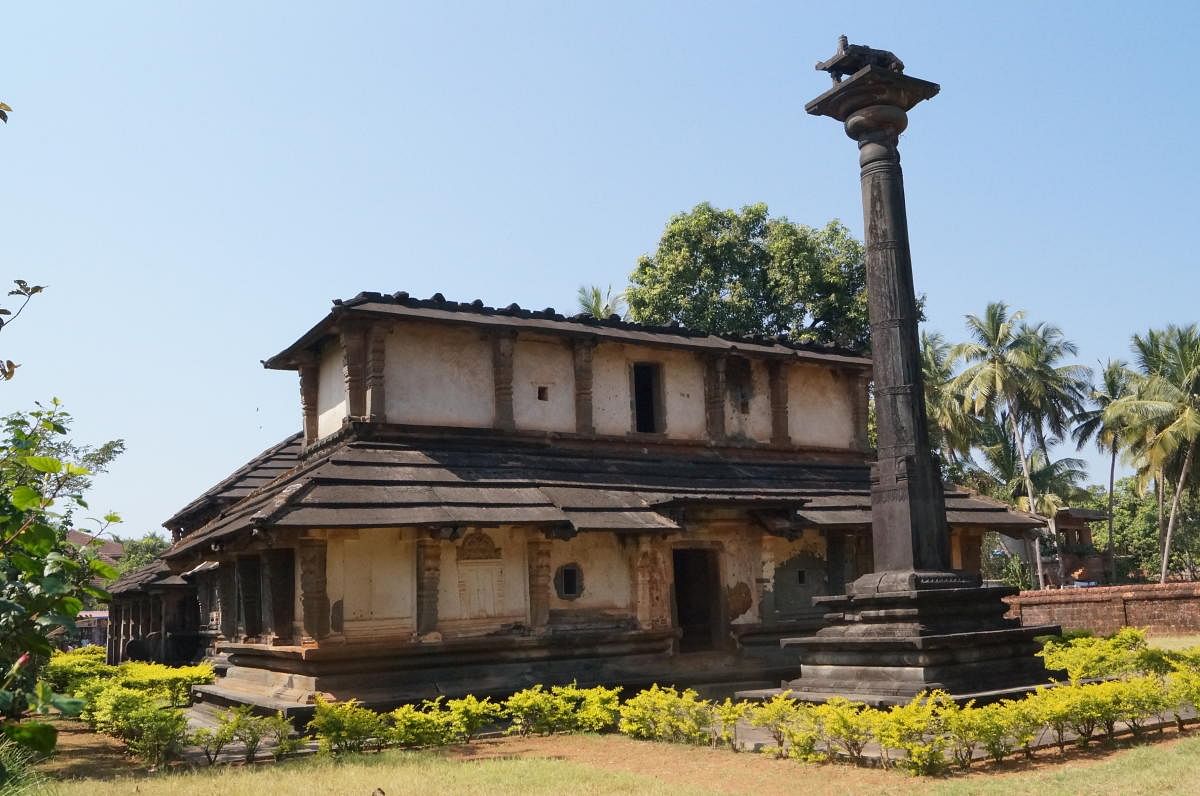
Long before the modern era of resort politics, in what was the Golden Age of Karnataka, horse-trading, in its literal sense, used to be a noble profession. In the vast Vijayanagar Empire (1336-1565 AD) that stretched around Hampi from coast to coast, there was no port more important than Bhatkal. Located by the Arabian Sea, merchants from across the world came here to sell their wares, especially horses from Arabia and weapons in exchange for sugar, pepper, spices and fine white rice. The Vijayanagar kings magnanimously paid even for a dead horse that did not survive the sea voyage, provided a tail was produced! Many of Bhatkal’s temples and Jain basadis were built during this period of prosperity. Emperor Krishnadevaraya allowed the Portuguese to build a fort here in 1510, but little of it survives today.
A Jain hub
As we explored Bhatkal’s ancient bylanes, vestiges of its Jain legacy peeped through. The town was named Bhatakala after the Jain grammarian Bhattakalanka Deva, who hailed from Haduvalli, 16 km away, capital of the Saluvas of Gerusoppa. Crammed between shops in the crowded marketplace stood a tall granite pillar marking the entry to a squat shrine with ornate balustrades and dwarapalas (door guardians). Parshvanatha Basadi, dedicated to the 23rd Jain tirthankara, was built in Vijayanagar style in 1545 with donations from Bhatkal’s traders during the reign of Queen Chennadeviamma of Haduvalli. With the decline of the Vijayanagar Empire, the doughty queen controlled local trade and battled the Portuguese who dubbed her ‘Raina da Pimenta’ or ‘Pepper Queen’.
Inscriptions dating a hundred years prior to the temple’s construction describe acts of war, worship, faith and sacrifice. One inscription mentions a Portuguese raid on Bhatkal on October 23, 1542, and describes how the Portuguese captain laid siege to the city, burnt it down, and marched towards the palace. Warrior Enkapa Nayaka died a hero’s death while battling the enemy at the gates. Another inscription records how the grateful queen made a grant of land to the slain warrior’s brother, who donated money for worship in this basadi in Enkappa’s memory.
Jattappa Nayakana Chandranatheshvara Basadi is Bhatkal’s largest Jain temple, and was built in 1556 by Narana Nayaka, son of a general in the queen’s army. The two-storeyed structure had three chambers on each floor, which housed images of tirthankaras. Inscriptions in the complex describe Bhatkal as a ‘town of palaces and shrines glowing with the riches and splendour of the kingdom’. Trade not only shaped the fortunes of the historic town, it also altered its cultural landscape.
Many Saraswat Brahmin business families and skilled Konkani craftsmen from Goa settled here to escape Portuguese persecution. Over time, Arabian traders intermingled with the local populace to form a new community. They were called ‘Nav-ayaths’ or ‘newly arrived’. Though they developed their own distinct identity, their dialect borrows heavily from Konkani, while local tastes blend seamlessly with Arabia. Today, their once-opulent mansions made of teak speak of a rich past.
We strolled past Ishaqi House and Barmavar House, as we stared in awe at the glass-panelled wooden screen outside a home called ‘Bab-e-Africa’. In the hot coastal climes, these screens kept the house airy and gave owners enough privacy. Windows had wooden slats that could be slid open for added ventilation. The spectacular Barnawi House, built in 1914, had colourful imported tiles and stained glass windows.
The friendly locals were so welcoming, they took us on a tour around Bhatkal. Jumma Masjid dated back to 1447 AD, but like other historic mosques, had been given a modern facelift. East of town at Moodbhatkal was the stone temple of Ketapai or Kethapayya Narayana with its lofty flagpole and lovely granite carvings. Located in a field of coconut and adike (betelnut) trees, the temple was locally known as Adike Narayana! Chitrapur Mutt at Shirali nearby housed the samadhi (remains) of six seers and an art gallery.
At Hashim Bakery, we tried local eats and noticed strange drinks we had never heard of — ‘lutfi’, ‘cold sip’, ‘sizzler’, ‘army’. Entire shelves were lined with jars of Bhatkali lon miri or red chilli paste and aale lahsoon or ginger-garlic masala paste, the heart and soul of Navayathi cuisine.
Food matters
Bhatkal is also famous for its godi halwa, a glutinous sweet made of wheat extract. We woke up at dawn to visit the home workshop of Bhatkal Super Halwa on Bunder Road. Nazeer, Israj and Yakub took turns to continuously stir the large cauldron before pouring the thick gooey sweet into trays to cool. It was then cut into cubes and packed in boxes to be dispatched to local shops. At Hotel Kwality, we had our first taste of the delicately light Bhatkali chicken biryani.
A chance encounter with local restaurateur Syed Jaleel at his popular eatery Chillies over a delicious seafood spread led to conversations on food. He graciously invited us home for a cooking session and a meal. Besides Bhatkali mutton dum biryani, we learnt how to make unique local specialties like shaiyya jhinga biryani(vermicelli prawn biryani) with sirke ka pyaaz (onions in vinegar) and baingan ka khatta (tangy brinjal curry).
While most travellers along the Canara Coast tend to bypass Bhatkal, we were glad to have stopped by at this little gem of a town hiding in plain sight.